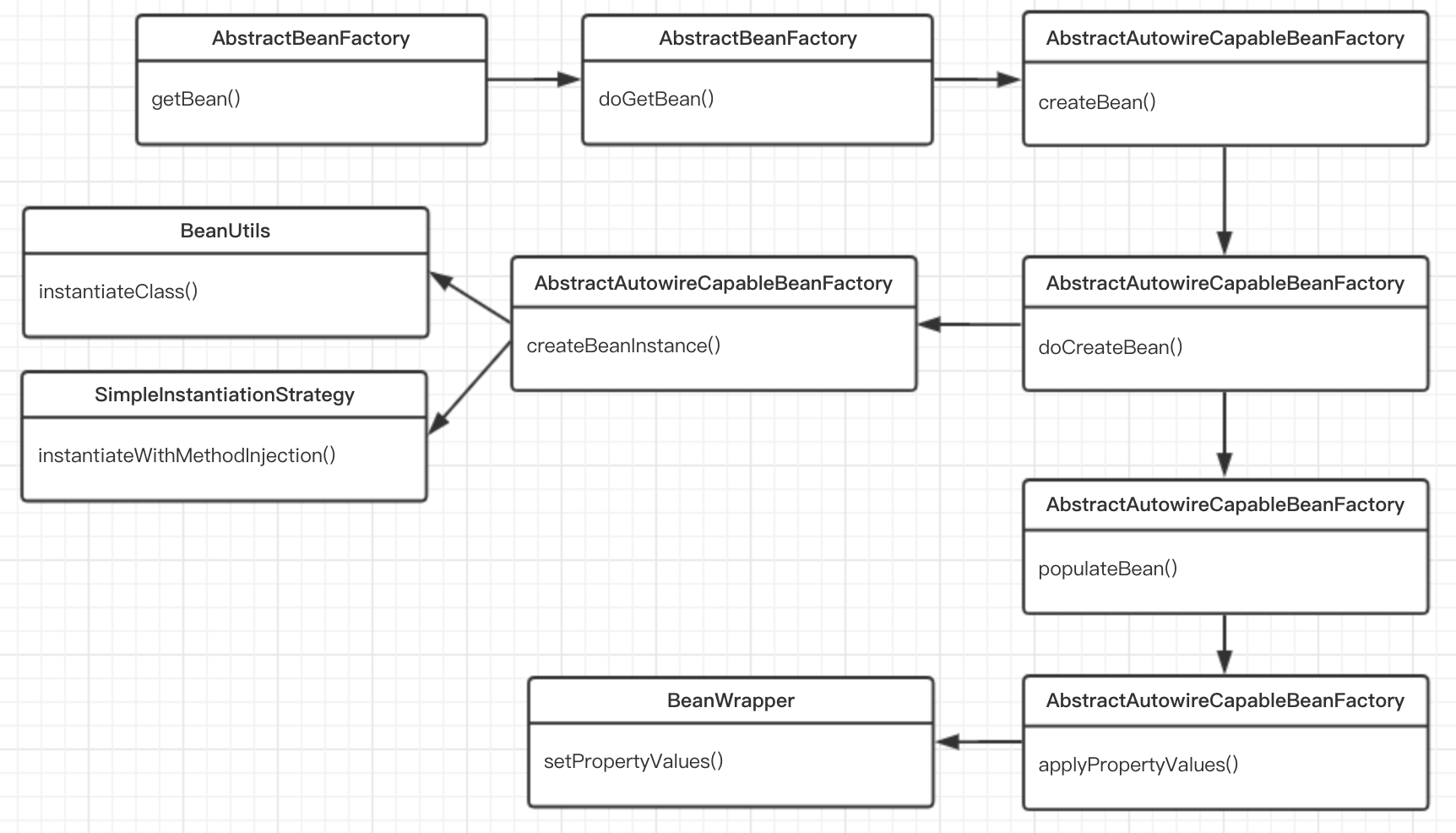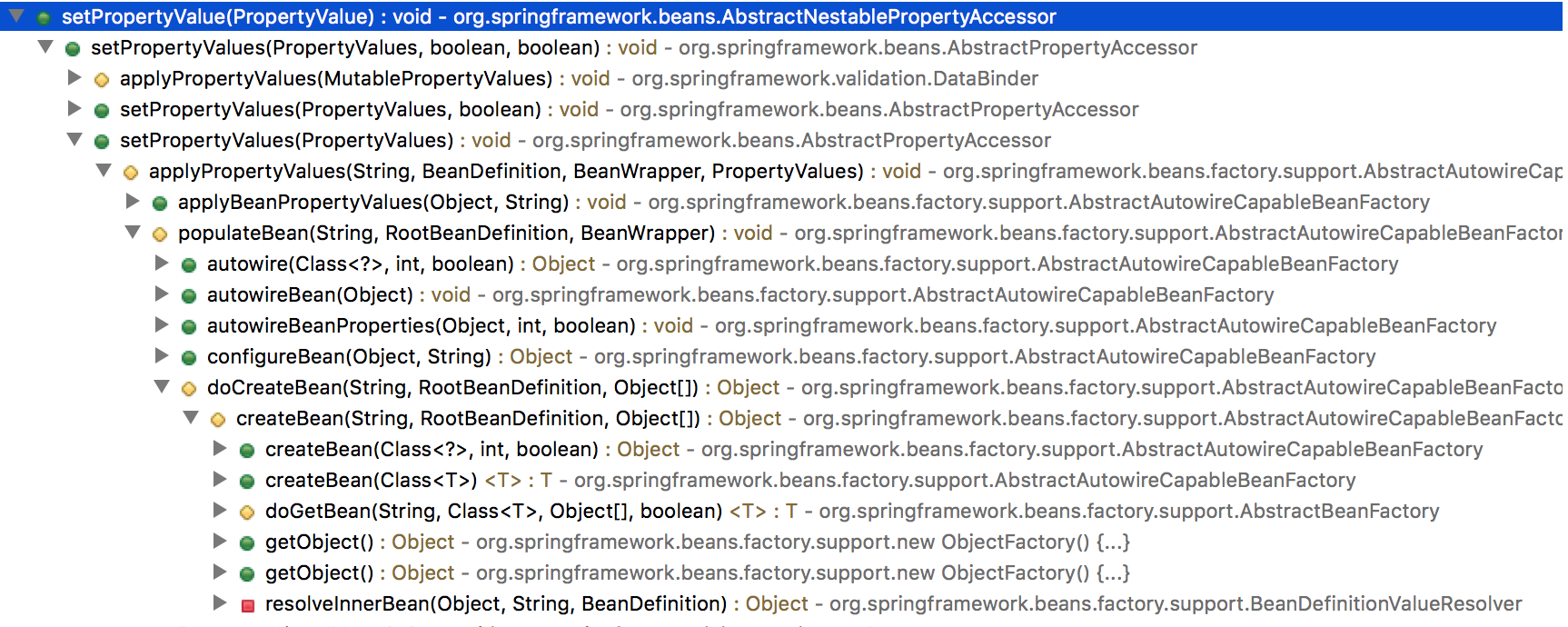我们分析了IOC容器的初始化,可以看出初始化其实就是在IoC容器中建立BeanDefinition数据映射,但并没有对Bean的依赖关系进行注入,依赖注入是用户第一次向IoC容器索要Bean的时候触发的,调用BeanFactory的getBean方法将触发依赖注入,这个时候才会创建对象实例,也可以通过设置bean的lazy-init属性来让bean的实例化过程在容器初始化的过程就完成,如果通过设置Bean的lazy-init属性,那么在容器初始化这个bean的时候就会调用getBean去触发依赖注入。
如果doGetBean方法在当前的IoC容器中找不到Bean,会到双亲BeanFactory中去取,如果当前的双亲容器找不到那就再顺着双亲BeanFactory链一直向上寻找。
get某一个Bean的时候会依赖注入其所依赖的所有的Bean,触发getBean的递归调用,直到取到一个没有任何依赖的bean为止。
依赖注入实现过程图:
依赖注入比较重要的两个方法:createBeanInstance和populateBean
createBeanInstance实例化Bean对象
protected Object doCreateBean(final String beanName, final RootBeanDefinition mbd, final Object[] args) {
// Instantiate the bean.
BeanWrapper instanceWrapper = null;
if (mbd.isSingleton()) {
instanceWrapper = this.factoryBeanInstanceCache.remove(beanName);
}
if (instanceWrapper == null) {
instanceWrapper = createBeanInstance(beanName, mbd, args);
}
final Object bean = (instanceWrapper != null ? instanceWrapper.getWrappedInstance() : null);
Class<?> beanType = (instanceWrapper != null ? instanceWrapper.getWrappedClass() : null);
// Allow post-processors to modify the merged bean definition.
synchronized (mbd.postProcessingLock) {
if (!mbd.postProcessed) {
applyMergedBeanDefinitionPostProcessors(mbd, beanType, beanName);
mbd.postProcessed = true;
}
}
// Eagerly cache singletons to be able to resolve circular references
// even when triggered by lifecycle interfaces like BeanFactoryAware.
boolean earlySingletonExposure = (mbd.isSingleton() && this.allowCircularReferences &&
isSingletonCurrentlyInCreation(beanName));
if (earlySingletonExposure) {
if (logger.isDebugEnabled()) {
logger.debug("Eagerly caching bean '" + beanName +
"' to allow for resolving potential circular references");
}
addSingletonFactory(beanName, new ObjectFactory<Object>() {
@Override
public Object getObject() throws BeansException {
return getEarlyBeanReference(beanName, mbd, bean);
}
});
}
// Initialize the bean instance.
Object exposedObject = bean;
try {
populateBean(beanName, mbd, instanceWrapper);
if (exposedObject != null) {
exposedObject = initializeBean(beanName, exposedObject, mbd);
}
}
catch (Throwable ex) {
if (ex instanceof BeanCreationException && beanName.equals(((BeanCreationException) ex).getBeanName())) {
throw (BeanCreationException) ex;
}
else {
throw new BeanCreationException(mbd.getResourceDescription(), beanName, "Initialization of bean failed", ex);
}
}
if (earlySingletonExposure) {
Object earlySingletonReference = getSingleton(beanName, false);
if (earlySingletonReference != null) {
if (exposedObject == bean) {
exposedObject = earlySingletonReference;
}
else if (!this.allowRawInjectionDespiteWrapping && hasDependentBean(beanName)) {
String[] dependentBeans = getDependentBeans(beanName);
Set<String> actualDependentBeans = new LinkedHashSet<String>(dependentBeans.length);
for (String dependentBean : dependentBeans) {
if (!removeSingletonIfCreatedForTypeCheckOnly(dependentBean)) {
actualDependentBeans.add(dependentBean);
}
}
if (!actualDependentBeans.isEmpty()) {
throw new BeanCurrentlyInCreationException(beanName,
"Bean with name '" + beanName + "' has been injected into other beans [" +
StringUtils.collectionToCommaDelimitedString(actualDependentBeans) +
"] in its raw version as part of a circular reference, but has eventually been " +
"wrapped. This means that said other beans do not use the final version of the " +
"bean. This is often the result of over-eager type matching - consider using " +
"'getBeanNamesOfType' with the 'allowEagerInit' flag turned off, for example.");
}
}
}
}
// Register bean as disposable.
try {
registerDisposableBeanIfNecessary(beanName, bean, mbd);
}
catch (BeanDefinitionValidationException ex) {
throw new BeanCreationException(mbd.getResourceDescription(), beanName, "Invalid destruction signature", ex);
}
return exposedObject;
}createBeanInstance中生成了Bean所包含的Java对象,Spring中用SimpleInstantiationStrategy类来生成Bean对象的实例,实例化Java对象的方法有两种:
1、通过BeanUtils,它使用了JVM的反射功能来生成Java对象实例
2、用CGLIB来生成,CGLIB是一种常用的字节码生成器的类库
@Override
public Object instantiate(RootBeanDefinition bd, String beanName, BeanFactory owner) {
// Don't override the class with CGLIB if no overrides.
if (bd.getMethodOverrides().isEmpty()) {
Constructor<?> constructorToUse;
synchronized (bd.constructorArgumentLock) {
constructorToUse = (Constructor<?>) bd.resolvedConstructorOrFactoryMethod;
if (constructorToUse == null) {
final Class<?> clazz = bd.getBeanClass();
if (clazz.isInterface()) {
throw new BeanInstantiationException(clazz, "Specified class is an interface");
}
try {
if (System.getSecurityManager() != null) {
constructorToUse = AccessController.doPrivileged(new PrivilegedExceptionAction<Constructor<?>>() {
@Override
public Constructor<?> run() throws Exception {
return clazz.getDeclaredConstructor((Class[]) null);
}
});
}
else {
constructorToUse = clazz.getDeclaredConstructor((Class[]) null);
}
bd.resolvedConstructorOrFactoryMethod = constructorToUse;
}
catch (Throwable ex) {
throw new BeanInstantiationException(clazz, "No default constructor found", ex);
}
}
}
//通过BeanUtils进行实例化,从这个方法中可以看到具体调用了ctor.newInstance()方法
return BeanUtils.instantiateClass(constructorToUse);
}
else {
// 使用CGLIB来实例化对象
return instantiateWithMethodInjection(bd, beanName, owner);
}
}Bean对象生成好了之后,Spring用BeanWrapper来持有创建出来的Bean对象,接下来Spring通过populateBean方法来把这些Bean对象的依赖关系设置好,以完成整个依赖注入的过程。
依赖注入的发生是在BeanWrapper的setPropertyValues中,具体的实现过程在其子类BeanWrapperImpl;createBeanInstance方法返回值就是一个BeanWrapper对象。再把BeanWrapper对象作为一个形参传入populateBean中。populateBean是对Bean的初始化,依赖注入就发生在这里。
protected void populateBean(String beanName, RootBeanDefinition mbd, BeanWrapper bw) {
//这里通过解析BeanDefinition来获取property值
PropertyValues pvs = mbd.getPropertyValues();
if (bw == null) {
if (!pvs.isEmpty()) {
throw new BeanCreationException(
mbd.getResourceDescription(), beanName, "Cannot apply property values to null instance");
}
else {
// Skip property population phase for null instance.
return;
}
}
// Give any InstantiationAwareBeanPostProcessors the opportunity to modify the
// state of the bean before properties are set. This can be used, for example,
// to support styles of field injection.
boolean continueWithPropertyPopulation = true;
if (!mbd.isSynthetic() && hasInstantiationAwareBeanPostProcessors()) {
for (BeanPostProcessor bp : getBeanPostProcessors()) {
if (bp instanceof InstantiationAwareBeanPostProcessor) {
InstantiationAwareBeanPostProcessor ibp = (InstantiationAwareBeanPostProcessor) bp;
if (!ibp.postProcessAfterInstantiation(bw.getWrappedInstance(), beanName)) {
continueWithPropertyPopulation = false;
break;
}
}
}
}
if (!continueWithPropertyPopulation) {
return;
}
//开始进行依赖注入的过程,先处理autowire的注入,可以根据Bean的名字或类型来完成Bean的autowire
if (mbd.getResolvedAutowireMode() == RootBeanDefinition.AUTOWIRE_BY_NAME ||
mbd.getResolvedAutowireMode() == RootBeanDefinition.AUTOWIRE_BY_TYPE) {
MutablePropertyValues newPvs = new MutablePropertyValues(pvs);
// Add property values based on autowire by name if applicable.
if (mbd.getResolvedAutowireMode() == RootBeanDefinition.AUTOWIRE_BY_NAME) {
autowireByName(beanName, mbd, bw, newPvs);
}
// Add property values based on autowire by type if applicable.
if (mbd.getResolvedAutowireMode() == RootBeanDefinition.AUTOWIRE_BY_TYPE) {
autowireByType(beanName, mbd, bw, newPvs);
}
pvs = newPvs;
}
boolean hasInstAwareBpps = hasInstantiationAwareBeanPostProcessors();
boolean needsDepCheck = (mbd.getDependencyCheck() != RootBeanDefinition.DEPENDENCY_CHECK_NONE);
if (hasInstAwareBpps || needsDepCheck) {
PropertyDescriptor[] filteredPds = filterPropertyDescriptorsForDependencyCheck(bw, mbd.allowCaching);
if (hasInstAwareBpps) {
for (BeanPostProcessor bp : getBeanPostProcessors()) {
if (bp instanceof InstantiationAwareBeanPostProcessor) {
InstantiationAwareBeanPostProcessor ibp = (InstantiationAwareBeanPostProcessor) bp;
pvs = ibp.postProcessPropertyValues(pvs, filteredPds, bw.getWrappedInstance(), beanName);
if (pvs == null) {
return;
}
}
}
}
if (needsDepCheck) {
checkDependencies(beanName, mbd, filteredPds, pvs);
}
}
//对属性进行注入
applyPropertyValues(beanName, mbd, bw, pvs);
}populateBean解析BeanDefinition中设置的property值,获取到Bean的依赖信息并设置Bean的依赖关系。通过使用BeanDefinitionResolver对BeanDefinition进行解析,然后注入到property中。
resolveValueIfNecessary方法包含了对所有的注入类型的处理,里面包含各种instanceof的判断,比如RuntimeBeanReference,Array,List,Map等数据类型,RuntimeBeanReference是在对BeanDefinition进行解析时生成的数据对象,是在载入BeanDefinition时根据配置生成的,如果RuntimeBeanReference是在双亲容器中则从双亲容器中去获取Bean(通过getBean方法)。
protected void applyPropertyValues(String beanName, BeanDefinition mbd, BeanWrapper bw, PropertyValues pvs) {
if (pvs == null || pvs.isEmpty()) {
return;
}
MutablePropertyValues mpvs = null;
List<PropertyValue> original;
if (System.getSecurityManager() != null) {
if (bw instanceof BeanWrapperImpl) {
((BeanWrapperImpl) bw).setSecurityContext(getAccessControlContext());
}
}
if (pvs instanceof MutablePropertyValues) {
mpvs = (MutablePropertyValues) pvs;
if (mpvs.isConverted()) {
// Shortcut: use the pre-converted values as-is.
try {
bw.setPropertyValues(mpvs);
return;
}
catch (BeansException ex) {
throw new BeanCreationException(
mbd.getResourceDescription(), beanName, "Error setting property values", ex);
}
}
original = mpvs.getPropertyValueList();
}
else {
original = Arrays.asList(pvs.getPropertyValues());
}
TypeConverter converter = getCustomTypeConverter();
if (converter == null) {
converter = bw;
}
BeanDefinitionValueResolver valueResolver = new BeanDefinitionValueResolver(this, beanName, mbd, converter);
// Create a deep copy, resolving any references for values.
List<PropertyValue> deepCopy = new ArrayList<PropertyValue>(original.size());
boolean resolveNecessary = false;
for (PropertyValue pv : original) {
if (pv.isConverted()) {
deepCopy.add(pv);
}
else {
String propertyName = pv.getName();
Object originalValue = pv.getValue();
Object resolvedValue = valueResolver.resolveValueIfNecessary(pv, originalValue);
Object convertedValue = resolvedValue;
boolean convertible = bw.isWritableProperty(propertyName) &&
!PropertyAccessorUtils.isNestedOrIndexedProperty(propertyName);
if (convertible) {
convertedValue = convertForProperty(resolvedValue, propertyName, bw, converter);
}
// Possibly store converted value in merged bean definition,
// in order to avoid re-conversion for every created bean instance.
if (resolvedValue == originalValue) {
if (convertible) {
pv.setConvertedValue(convertedValue);
}
deepCopy.add(pv);
}
else if (convertible && originalValue instanceof TypedStringValue &&
!((TypedStringValue) originalValue).isDynamic() &&
!(convertedValue instanceof Collection || ObjectUtils.isArray(convertedValue))) {
pv.setConvertedValue(convertedValue);
deepCopy.add(pv);
}
else {
resolveNecessary = true;
deepCopy.add(new PropertyValue(pv, convertedValue));
}
}
}
if (mpvs != null && !resolveNecessary) {
mpvs.setConverted();
}
// Set our (possibly massaged) deep copy.
try {
bw.setPropertyValues(new MutablePropertyValues(deepCopy));
}
catch (BeansException ex) {
throw new BeanCreationException(
mbd.getResourceDescription(), beanName, "Error setting property values", ex);
}
}完成解析过程后就已经是为依赖注入做好了准备条件,依赖注入的发生是在BeanWrapper的setPropertyValues中,具体的实现过程在其子类BeanWrapperImpl。
setPropertyValue的方法调用栈:
共同学习,写下你的评论
评论加载中...
作者其他优质文章







